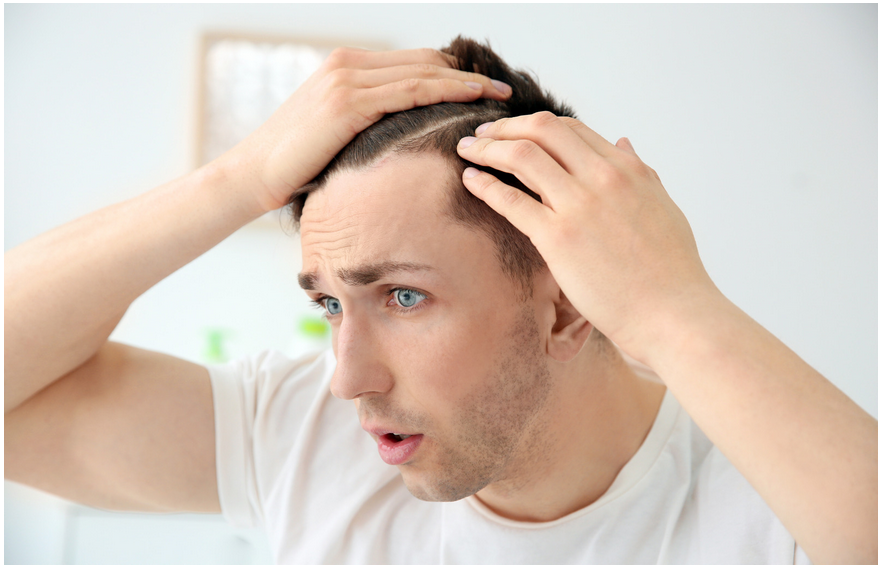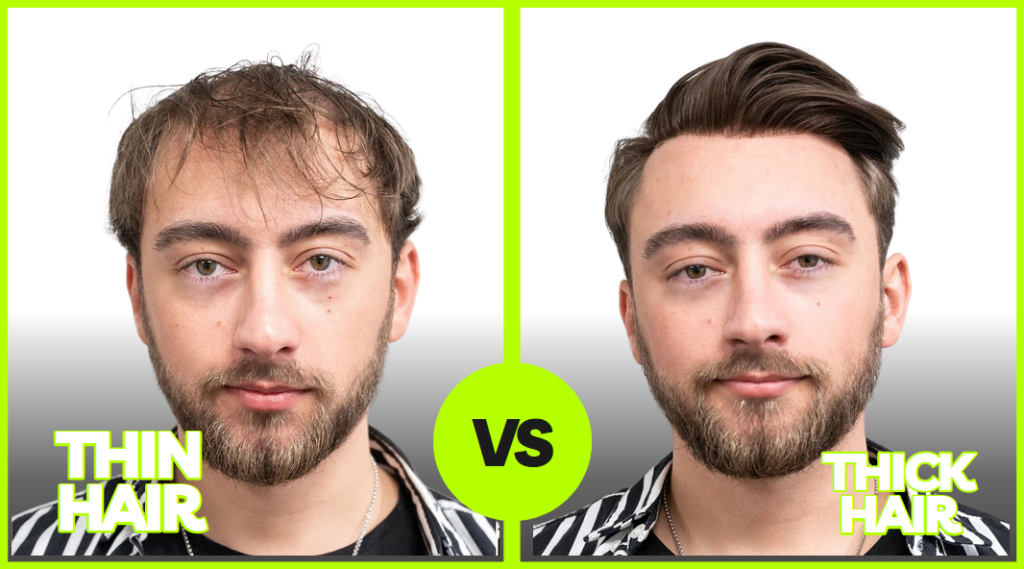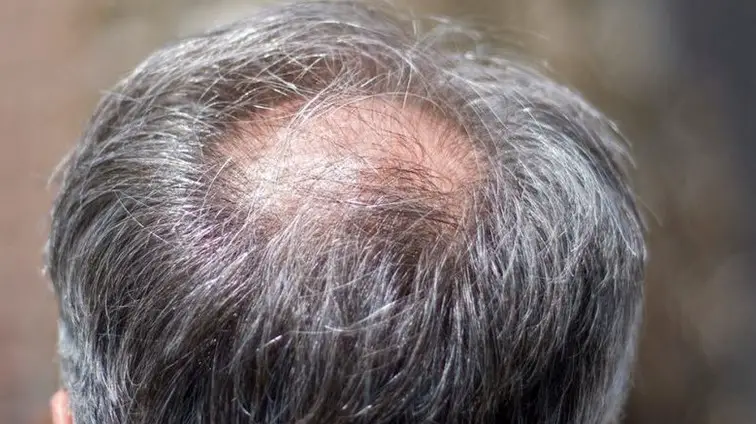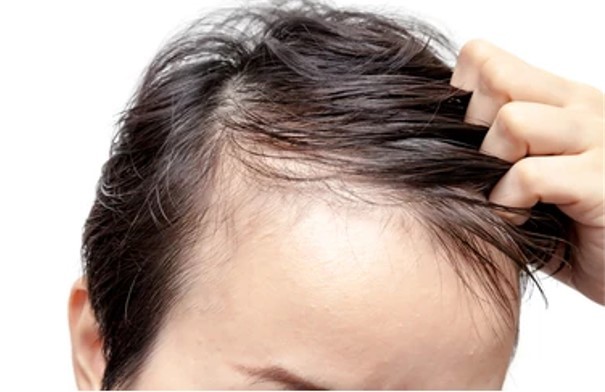Explore the differences between thin hair vs thick hair in males, including styling tips, the best products, and how to identify your hair type for optimal care.
In the intricate tapestry of male grooming, the debate of thin Hair vs Thick Hair in males often takes center stage. This dichotomy is not just a matter of aesthetics but also a reflection of distinct biological nuances. Thin hair, characterized by its finer strands, often exudes a sleek and elegant aura. In contrast, thick hair boasts a robust and voluminous presence, often perceived as a symbol of vitality.
Key Takeaways
- Understanding your hair type, whether thin or thick, is essential for proper care and styling.
- Choose hair care products and styles that are specifically suited to your hair type for the best results.
- Treat your hair gently, regardless of its type, to prevent damage and maintain its health.
- Embracing your natural hair, in all its unique forms, is a journey towards self-acceptance and confidence.
- For more personalized advice, explore resources like guides on identifying hair thinning and styling fine hair.
Introduction to Hair Types and Textures
As someone who’s navigated the world of hair care for years, I’ve come to realize the importance of understanding the unique characteristics of our hair. It’s not just about style; it’s about embracing and caring for the hair we have, whether it’s thin or thick. Let’s dive into the diverse world of hair types, focusing on their textures and thickness, and discover why knowing your hair type is crucial.
Hey there! Some links on this page are affiliate links which means that, if you choose to make a purchase, I may earn a small commission at no extra cost to you. I greatly appreciate your support!
Hair, in its beautiful complexity, varies greatly from person to person. It can be as unique as a fingerprint, with variations in texture ranging from straight to curly, and thickness from fine to thick. Here’s a quick rundown:
- Texture: This refers to the natural shape or pattern of your strands. It can be straight, wavy, curly, or coily.
- Thickness: This is about the density of your hair. Do you have a full head of thick hair, or is it finer and more sparse?
Understanding these aspects of your hair is more than just a cosmetic concern. It’s about knowing how to care for your hair properly. Different hair types require different care routines, products, and styling methods. For instance, fine hair might need lighter products that don’t weigh it down, while thick hair might require more moisturizing elements.
Now, why is this important? Well, identifying your hair type is the first step in a journey towards healthier hair. It helps in choosing the right products and styles that not only enhance your look but also maintain the health of your hair. For example, if you have thin hair, you might benefit from volumizing products, whereas thick hair might need more hydration.
If you’re curious about how to identify your hair type or looking for tips on how to care for it, check out our detailed guides on hair thinning on the sides and thin natural hair. These resources are packed with expert advice and practical tips to help you embrace and care for your hair, no matter its type.
Remember, every hair type is beautiful, and understanding yours is the key to unlocking its full potential. Let’s cherish and care for our hair, as it’s an integral part of who we are!

What is Fine Hair?
In my journey through the intricate world of hair care, I’ve often encountered the question: What exactly is fine hair? Understanding this can be a game-changer in how you care for your locks. Let me share some insights from my experience.
Fine hair refers to the diameter of each hair strand. It’s not about the quantity of hair on your scalp, but the thickness of each individual strand. Here are some key characteristics:
- Delicate Texture: Fine hair is often silky and smooth to the touch.
- Prone to Oiliness: Due to its thin nature, it can get oily quickly.
- Easily Weighed Down: Heavy products can make fine hair look flat.
Now, a common confusion I hear is whether fine hair is the same as thin hair. It’s crucial to clarify this: fine hair relates to the thickness of each strand, while thin hair refers to the overall density of hair on your scalp. You can have fine hair but a lot of it, or thick strands but not many of them.

No matter how much hair is gone — it CAN come back.
Stimulate growth safely and comfortably with FDA-PROVEN (LLLT) LASER THERAPY CAP. Hair Transplant Surgeon, Dr. Vikram Jayaprakash and Dermatologist, Dr. Russell Knudsen speak about how hair loss happens and why a laser cap is their preferred laser hair therapy device to help restore hair growth.
WATCH NOW
Understanding this distinction is vital in choosing the right hair care products and styles. For instance, if you have fine hair, you might benefit from lightweight volumizing products that don’t weigh your hair down.
If you’re looking to explore more about caring for fine hair, I recommend checking out our guide on thin crown hair. It’s filled with expert tips and tricks tailored for fine hair care.
Remember, every hair type has its unique beauty and challenges. Embracing your fine hair with the right knowledge and care can make all the difference in how it looks and feels!
What is Thick Hair?
In my extensive experience with hair care, I’ve often been asked about the essence of thick hair. It’s a term that’s frequently mentioned, but what does it really mean? Let me break it down for you.
Thick hair refers to the density of hair strands per square inch on your scalp. It’s not just about the width of each strand, but the overall volume and fullness your hair presents. Here are some defining attributes:
- Dense and Voluminous: Thick hair gives a fuller appearance.
- Strong Strands: Generally, each strand is robust and less prone to breakage.
- Holds Styles Well: Due to its volume, it can maintain hairstyles longer.
Now, let’s talk about the benefits of having thick hair. It’s a hair type many aspire to have because of its lush and vibrant look. Thick hair can be a fantastic canvas for various hairstyles, from sleek ponytails to voluminous curls. It often appears healthier and more lustrous, giving you a head-turning presence.
However, it’s important to remember that thick hair also requires specific care. It can be prone to frizz and may require more hydration than finer hair types. If you’re looking for tips on managing and styling thick hair, I suggest exploring our article on hair thinning on top for black males. It’s packed with valuable insights tailored for thick hair maintenance.
Embracing your thick hair with the right care and style can truly make it your crowning glory. Remember, every hair type is unique and beautiful in its own way!
Key Differences Between Thin and Thick Hair for Males
In my years of expertise in hair care, I’ve learned that understanding the key differences between thin and thick hair is essential for any male looking to optimize his hair care and styling routine. Let’s delve into these differences, focusing on the visual and textural aspects, and how they influence styling and care.
Visual Differences:
- Thin Hair: Often appears more sparse or see-through, especially at the crown or hairline.
- Thick Hair: Looks more dense and full, providing a richer visual texture.
Textural Differences:
- Thin Hair: Tends to be softer and more delicate to the touch.
- Thick Hair: Feels denser and more substantial when you run your fingers through it.
These differences aren’t just cosmetic; they play a significant role in how you should care for and style your hair. For instance, thin hair might require volumizing products to give it a fuller appearance, while thick hair might need heavier products to control and maintain its shape.
Styling and Care:
- Thin Hair:
- Use lighter styling products to avoid weighing it down.
- Gentle styling techniques are preferable to prevent breakage.
- Thick Hair:
- Can handle stronger hold products.
- Often requires more intensive conditioning to maintain health and sheen.
Understanding these nuances can make a world of difference in your daily hair care routine. If you’re looking for more in-depth advice tailored to your hair type, our articles on 7 signs of balding at 20 and seeing your scalp through thin hair offer a wealth of information.
Remember, whether you have thin or thick hair, embracing your natural hair type and learning the best ways to care for it can boost your confidence and showcase your personal style. Every hair type has its unique beauty and charm!
Thin Hair vs Thick Hair Male Test
In my experience, many guys are curious about whether they have thin or thick hair. Luckily, there’s a simple test you can do at home to find out. This knowledge is not just a trivial fact; it’s crucial in choosing the right hair care products and styles.
Here’s a quick and easy test to determine your hair thickness:
- The Strand Test: Take a single strand of your hair and lay it on a plain, contrasting background. If the strand is hard to see and feels very fine when you touch it, you likely have thin hair. If it’s clearly visible and feels a bit thicker between your fingers, you have thick hair.
- The Ponytail Test: This is for those with longer hair. If you can easily wrap a standard hair tie multiple times around your ponytail, you probably have thin hair. If you struggle to wrap it even twice, your hair is likely thick.
Understanding your hair type is the first step in caring for it properly.
Remember, every hair type has its unique beauty and challenges. Embracing your hair type with the right care can make all the difference in your hair’s health and appearance!
Hairstyles and Haircuts for Different Hair Types
Choosing the right hairstyle or haircut can significantly enhance your look, especially when it aligns with your hair type. As someone who’s navigated the complexities of hair care for years, I’ve learned that the key to a great hairstyle lies in understanding whether you have thin or thick hair. Let me share some styling tips and haircut ideas for both hair types.
For Thin Hair:
- Layered Cuts: Adding layers can create an illusion of volume and texture.
- Short to Medium Length: Keeping hair shorter can make it appear fuller.
- Texturizing Products: Use light products that add volume without weighing hair down.
For Thick Hair:
- Thinned Out Cuts: These can reduce bulk and make your hair more manageable.
- Longer Styles: Thick hair is well-suited for longer cuts, as it holds shape well.
- Moisturizing Products: Use products that tame frizz and add definition.
Remember, the right haircut can not only make your hair look great, but also make it easier to manage and style. If you’re looking for more hairstyle inspiration or specific advice for your hair type, our articles on thin crown hair and black male hair thinning on top offer a wealth of information.
Embrace your hair type, whether it’s thin or thick, and experiment with styles that bring out the best in you. A great haircut is more than just a fashion statement; it’s a form of self-expression and confidence!
Hair Care and Treatment
Navigating the world of hair care, especially for those experiencing thinning, can be a bit overwhelming. But fear not, I’m here to share some tried-and-tested tips and product recommendations that have worked wonders for me and many others.
Choosing the Right Shampoo and Products:
- For thinning hair, it’s essential to use a shampoo that promotes hair strength and scalp health. Look for products containing ingredients like biotin, keratin, or natural oils.
- Avoid heavy conditioners that can weigh down thin hair. Instead, opt for lightweight, volumizing conditioners.
Styling Tips for Fine and Thin Hair:
- Use a gentle touch when styling. Excessive pulling or tugging can lead to more hair loss.
- Heat styling should be minimal. If necessary, use a heat protectant spray.
- Volumizing sprays and mousses can be a game-changer, giving your hair that extra lift without the heaviness.
Remember, the key is to be gentle with your hair and scalp. Harsh chemicals or rough styling techniques can exacerbate hair thinning. For more in-depth guidance, especially if you’re dealing with hair thinning, I highly recommend checking out our comprehensive article on Topical Finasteride And Minoxidil. It’s packed with valuable tips and insights that can help you navigate this challenge.
Taking care of your hair, particularly when it’s thinning, requires patience and the right approach. But with the proper care and products, you can maintain the health and appearance of your hair, boosting your confidence and overall well-being.
Preventing Hair Loss and Promoting Growth
In my journey as a hair care enthusiast and writer, I’ve encountered numerous methods to minimize preventable hair loss and promote natural hair growth. Here, I’ll share some effective strategies that have proven beneficial for many.
Minimizing Preventable Hair Loss:
- Gentle Hair Care: Avoid tight hairstyles and harsh chemical treatments. Opt for gentle brushing and washing.
- Healthy Diet: Nutrition plays a crucial role. Ensure a balanced diet rich in vitamins and minerals, particularly those known to support hair health like iron, zinc, and vitamins A, C, and E.
- Stress Management: High stress can contribute to hair loss. Engage in stress-reducing activities like yoga, meditation, or regular exercise.
Promoting Natural Hair Growth:
- Scalp Massage: Regular scalp massages can stimulate blood flow to the scalp, encouraging hair growth.
- Natural Oils: Incorporate natural oils like coconut, castor, or rosemary oil into your hair care routine. They are known to support hair health and growth.
- Stay Hydrated: Adequate hydration is essential for healthy hair growth.
For more detailed information and specific product recommendations, I suggest exploring our article on best smelling shampoo and conditioner for fine hair. It’s a comprehensive guide that can help you make informed choices about your hair care products.
Remember, while genetics play a significant role in hair growth and loss, adopting these practices can make a noticeable difference in the health and appearance of your hair. Taking care of your hair is a form of self-care that can boost your overall well-being.
FAQs on Thin Hair vs Thick Hair in Males
In my role as a hair care expert, I often encounter a variety of questions about thin and thick hair in males. Let’s address some of the most common queries with clear, expert answers to help you better understand and care for your hair.
How to Tell if Your Hair is Thinning
Noticing hair thinning can be concerning, but recognizing the early signs can lead to more effective management. Here are some indicators:
- Increased Shedding: While some hair loss is normal, excessive shedding can be a sign of thinning.
- Widening Part: If your hair part seems to be getting wider, it could indicate thinning.
- Scalp Visibility: More visible scalp, especially at the crown, is a common sign of hair thinning.
If you’re noticing these signs and looking for ways to address them, our article on how to tell if you have thinning hair offers valuable insights and solutions.
Is Thin Hair the Same as Thinning Hair?
Understanding hair terminology is crucial in addressing hair concerns effectively. Thin hair and thinning hair are not the same:
- Thin Hair: Refers to the diameter of each hair strand. Thin hair is naturally fine and has a smaller diameter.
- Thinning Hair: Indicates a reduction in the number of hairs, often due to hair loss over time.
For those experiencing thinning hair and seeking advice, I recommend our comprehensive guide on signs of balding, which provides in-depth information and practical tips.
Remember, whether you have thin hair or are experiencing thinning hair, there are numerous ways to care for your hair and maintain its health and appearance. Understanding your hair type and condition is the first step in this journey.
Conclusion
As we wrap up our exploration of thin and thick hair in males, it’s important to reflect on the key insights we’ve shared. My experience in the field of hair care has taught me that understanding your hair type is not just about aesthetics; it’s about nurturing and making the best choices for your hair’s health and style.
Remember, every hair type has its unique beauty and challenges. Embracing your natural hair, whether it’s thin, thick, or somewhere in between, is a journey towards self-acceptance and confidence.
For more in-depth advice and personalized tips, don’t hesitate to explore our other resources, such as the guide on how to tell if your hair is thinning and tips for styling fine hair. These articles are designed to provide you with comprehensive information and practical solutions.
In conclusion, your hair is a vital part of your identity. Taking the time to understand and care for it properly can enhance not just your appearance but also your overall well-being.
Written by Anthony Wedderburn:Medically Team reviewed by
Dr. Ljuba Zsolnai and updated. With professional help, Anthony research and only provide content that delivers results. The name "Stages of Balding" accurately reflects the blog's purpose: to provide practical solutions and guidance without requiring extensive research on the reader's part.








